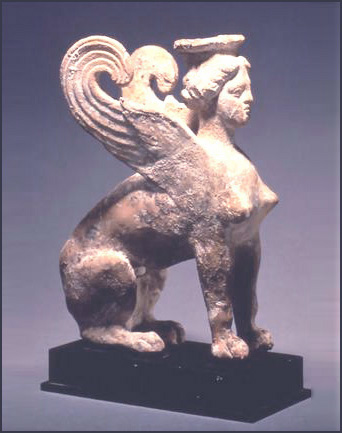Sigmund
Freud

| Sphinx Greek, South Italian, late 5th-early 4th century BC. Terracotta, 21.0 x 15.0 x 8.0 cm Collection Freud Museum London |
Freud stated: 'The psychoanalyst, like the archaeologist, must uncover layer after layer of the patient's psyche, before coming to the deepest, most valuable treasures'.
Though Freud prescribed the intense, inner journey of psychoanalysis for Vienna's bourgeoisie, his own therapy was shopping. Arranging choice items on his desk, Freud confessed to Carl Gustav Jung: 'I must always have an object to love.'
Freud made the myth of Oedipus and the Sphinx central to psychoanalysis. He wrote: 'A single idea of general value dawned on me. I have found, in my own case too (the phenomenon of) being in love with my mother and jealous of my father, and I now consider it a universal event in early childhood.'
Freud believed this powerful instinctual urge explained the development of sexual identity in both men and women.
In Egyptian art, the Sphinx was a protective, benevolent male figure who represented the pharaoh. In Greek art, the Sphinx was female, and associated with death and funerary monuments. In Sophocles' play, Oedipus Rex, she is the destructive trickster whom Oedipus must outsmart to save the city of Thebes, and his own life. Sphinx wears the polos, or headdress of the goddess. She is a powerful, magical, hybrid being, part woman, part eagle, part lion.
Ancient art is fundamental to an understanding of civilisation, imagination, humanity itself. Without it, there is no context for contemporary society or thought. It is the beginning and the continuity of our ideas and identity.